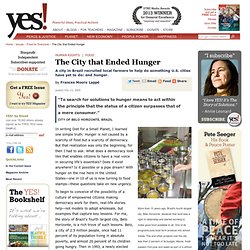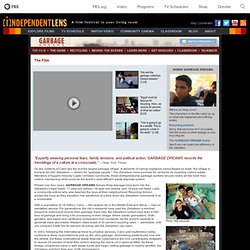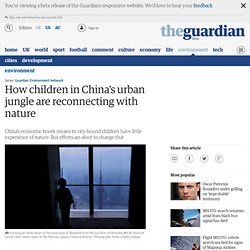

The City that Ended Hunger. A city in Brazil recruited local farmers to help do something U.S. cities have yet to do: end hunger. posted Feb 13, 2009 “To search for solutions to hunger means to act within the principle that the status of a citizen surpasses that of a mere consumer.”CITY OF BELO HORIZONTE, BRAZIL In writing Diet for a Small Planet, I learned one simple truth: Hunger is not caused by a scarcity of food but a scarcity of democracy.

But that realization was only the beginning, for then I had to ask: What does a democracy look like that enables citizens to have a real voice in securing life’s essentials? Does it exist anywhere? To begin to conceive of the possibility of a culture of empowered citizens making democracy work for them, real-life stories help—not models to adopt wholesale, but examples that capture key lessons.
The city agency developed dozens of innovations to assure everyone the right to food, especially by weaving together the interests of farmers and consumers. The cost of these efforts? Adaptable House caters for growing family, home office, retired living, or divorce. It uses sliding partitions and storage walls, extension modules and a puzzle of garden components.

Danish architects Henning Larsen's new Adaptable House is designed to accommodate the most common lifestyle changes, from having children to settling into retirement. The energy-efficient home can even be fairly separated in case of divorce. View all Realized with developers Realdania Byg and contractors GXN, the Adaptable House not only offers flexible room arrangements, but has a built-in strategy for extending and separating volumes. The house has also been designed to consume 37 percent less energy than a standard home, with a significant reduction in overall carbon emissions. Pre-figuring life changes The Adaptable House was conceived to help meet a range of lifestyle changes. Perhaps the most innovative and coolly pragmatic gesture is in adapting for divorce.
In Photos: Artwork created from discarded cigarette butts. In Photos: Artwork created from discarded cigarette butts Cigarettes aren’t only bad for your health but statistics point out that they’re even worse for the environment.

According to recent statistics, about 1.1 billion people in the world are smokers and about 10 million cigarettes are purchased every minute around the world. Apart from creating a plume of toxic gases, cigarettes leave a much longer effect on the environment in the form of cigarette butts. Cigarette butts can take up to 12 years to degrade. Documentary Film. “Expertly weaving personal fears, family tensions, and political action, GARBAGE DREAMS records the tremblings of a culture at a crossroads.”

—New York Times On the outskirts of Cairo lies the world's largest garbage village. A labyrinth of narrow roadways camouflaged by trash, the village is home to 60,000 Zaballeen — Arabic for "garbage people. " The Zaballeen have survived for centuries by recycling Cairo's waste. Members of Egypt's minority Coptic Christian community, these entrepreneurial garbage workers recycle nearly all the trash they collect, maintaining what could be the world’s most efficient waste disposal system. Filmed over four years, GARBAGE DREAMS follows three teenage boys born into the Zaballeen's trash trade: 17-year-old Adham, 16-year-old Osama, and 18-year-old Nabil.
With a population of 18 million, Cairo — the largest city in the Middle East and Africa — has no sanitation service. Environmental Toxins Article, Toxicology Information, Chemical Facts. My journalist-as-guinea-pig experiment is taking a disturbing turn.

A Swedish chemist is on the phone, talking about flame retardants, chemicals added for safety to just about any product that can burn. Found in mattresses, carpets, the plastic casing of televisions, electronic circuit boards, and automobiles, flame retardants save hundreds of lives a year in the United States alone. These, however, are where they should not be: inside my body. Åke Bergman of Stockholm University tells me he has received the results of a chemical analysis of my blood, which measured levels of flame-retarding compounds called polybrominated diphenyl ethers. How children in China's urban jungle are reconnecting with nature. We all met by the roadside before setting off for the nature camp.

It was a clear, early-spring morning and several of the children played on a dusty patch of ground next to a run-down factory. We grabbed one of the girls as she ran past. "Do you like it here? " we asked. "Yes," she shot back. "Really? " "Yes! " And off she ran. "What are you doing? " "Making a cake! " The child who answered didn't even look up, being too busy adding leaves to the "cake". And – sure enough – when we got to our destination and saw the orchards, grass, ponds and hills, they whizzed off like escaped rabbits. I still feel the same mix of happiness and sadness every time children get out of the car and run off shouting, ignoring any calls to return.
China's rapid economic development has changed much of the country's appearance. City kids in China became cave-dwellers in an urban jungle long ago. Green Hope Action sees volunteers from the city visit poor villages to provide environmental education. America's Most Toxic Cities, 2011.